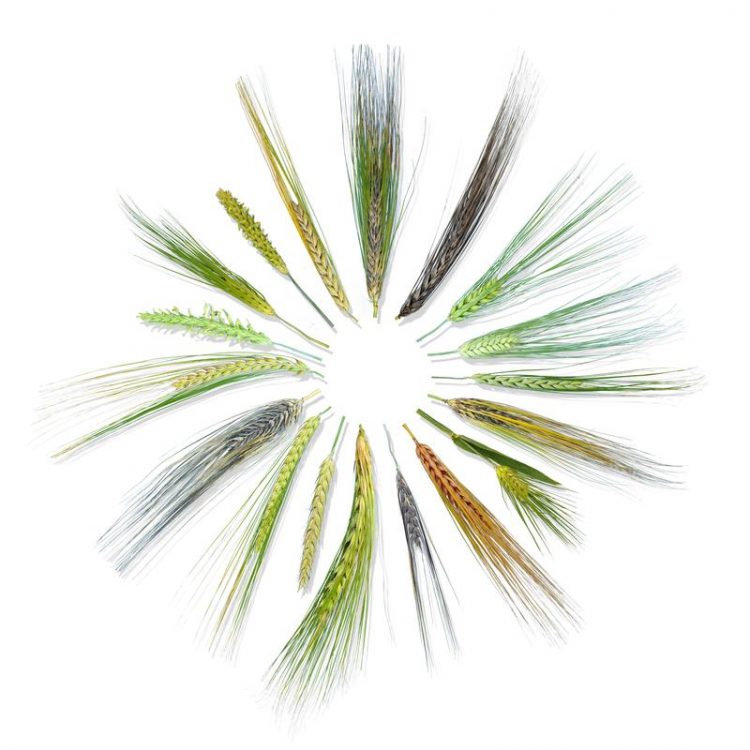The dawn of a new era for genebanks – molecular characterisation of an entire genebank collection

Illustrated variety of different barley accessions. IPK Gatersleben
Genebanks store samples of cultivars, landraces and wild relatives of crop plants from all over the world to safeguard our agricultural heritage and exploit it for future crop improvement.
The German federal ex situ gene bank at IPK in Gatersleben hosts one of the world’s most comprehensive collections of cultivated plants, including 22,000 barley seed samples.
Under the leadership of the IPK Gatersleben, researchers from the German Centre for Integrative Biodiversity Research (iDiv), the Julius Kühn Institute (JKI, German Federal Research Centre for Cultivated Plants) in Quedlinburg and the University of Göttingen collaborated with colleagues from Japan, China, and Switzerland. This international cooperation revealed how well the IPK collection represents global barley diversity.
A single plant was genotyped for each of more than 22,000 seed samples, enabling the scientists to identify duplicate samples within the collection. Opening up new ways for genetically informed quality management, this comprehensive dataset also guides the effective use of the collection in research and breeding by pinpointing lines for further in-depth characterization.
Prof Dr Nils Stein (IPK Gatersleben and University of Göttingen) says: “This publication enables us to fully describe the wide range of morphological diversity of a worldwide genebank in terms of molecular genetics.” To do this, Stein and his team used a method called “genotyping by sequencing” (GBS).
The complete DNA sequence of the barley variety ‘Morex’, which was released in 2017, forms the basis of the present work. It serves as a high-quality sequence anchor for the GBS information. To characterise genetic diversity between cultivated and wild barley forms throughout the whole genome, the researchers searched for so-called SNPs (single nucleotide polymorphisms).
In total, they found more than 171,000 of these small DNA variants in the huge barley genome consisting of 5 billion base pairs. Stein adds: “This density is sufficient to find even very small differences between samples, but also to confidently flag pairs of duplicated samples in our collection.”
“We can now draw conclusions about the origin, distribution area and relationship between the barley populations hosted in our collection. All digital genetic data are publicly accessible and targeted queries can be submitted online.
A state-of-the art database combines traditional passport records with the new molecular data to inform research and breeding applications,” explains Dr Martin Mascher of the IPK and iDiv, who co-led the study. The combination of historical field data of the genebank with modern molecular analyses is an impressive showcase for the opportunities that still lie dormant within gene banks around the world.
New research methods and international collaborations have paved new ways for the preservation and use of this valuable genetic diversity. Prof Dr Frank Ordon from the Julius Kühn Institute (JKI) points out: “Detailed knowledge about genetic variability and its use are prerequisite for breeding new varieties adapted to a changing environment.
In the future, plant breeders will have to cope with heat, drought stress and new pathogens and also must adapt to changes regarding the use of fertilisers and pesticides. Genes that code for key properties can thus be detected in native species or related wild species more quickly and be used in breeding.”
In the past, the lack of genetic data at the level of whole collections limited practical applications of genetic diversity in breeding and research. Thanks to the new analysis and open research data, it will now be possible to search across 22,626 barley seed samples. To host this unique resource, the researchers developed the BRIDGE “Data Warehouse” as a first steps towards a bio-digital resource centre.
The BRIDGE project:
BRIDGE stands for “Biodiversity informatics to bridge the gap from genome information to educated utilisation of genetic diversity hosted in Genebanks”. Funded in frame of the Leibniz Competition, the project was launched on 1 May 2015 and has been financially supported for the past three years with nearly 1.2 million euros. The aim of BRIDGE is to develop appropriate procedures to connect genetic, genomic and phenotypic information about plant genetic resources preserved in gene banks, enabling fast and easy access to the collection by researchers and breeders. More information is available at: http://bridge.ipk-gatersleben.de/bridge/ .
Prof Dr Nils Stein
(IPK Gatersleben and Georg August University Göttingen)
Tel.: +49 39482 5522
E-mail: stein@ipk-gatersleben.de
Dr Martin Mascher
(IPK Gatersleben and iDiv Halle-Jena-Leipzig
Tel.: +49 39482 5243
E-Mail: mascher@ipk-gatersleben.de
Prof Dr Frank Ordon
(JKI)
Tel.: +49 3946 47602
E-Mail: frank.ordon@julius-kuehn.de
Sara G. Milner et al (2018): Genebank genomics highlights the diversity of a global barley collection, Nature Genetics. https://www.nature.com/articles/s41588-018-0266-x, DOI: 10.1038/s41588-018-0266-x .
http://www.ipk-gatersleben.de/genbank/genomik-genetischer-ressourcen/
http://www.ipk-gatersleben.de/unabhaengige-arbeitsgruppen/domestikationsgenomik/
http://www.julius-kuehn.de/en/resistance-research-and-stress-tolerance/
Media Contact
All latest news from the category: Life Sciences and Chemistry
Articles and reports from the Life Sciences and chemistry area deal with applied and basic research into modern biology, chemistry and human medicine.
Valuable information can be found on a range of life sciences fields including bacteriology, biochemistry, bionics, bioinformatics, biophysics, biotechnology, genetics, geobotany, human biology, marine biology, microbiology, molecular biology, cellular biology, zoology, bioinorganic chemistry, microchemistry and environmental chemistry.
Newest articles

High-energy-density aqueous battery based on halogen multi-electron transfer
Traditional non-aqueous lithium-ion batteries have a high energy density, but their safety is compromised due to the flammable organic electrolytes they utilize. Aqueous batteries use water as the solvent for…

First-ever combined heart pump and pig kidney transplant
…gives new hope to patient with terminal illness. Surgeons at NYU Langone Health performed the first-ever combined mechanical heart pump and gene-edited pig kidney transplant surgery in a 54-year-old woman…

Biophysics: Testing how well biomarkers work
LMU researchers have developed a method to determine how reliably target proteins can be labeled using super-resolution fluorescence microscopy. Modern microscopy techniques make it possible to examine the inner workings…





















